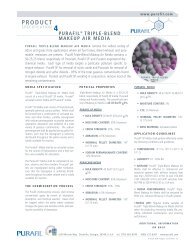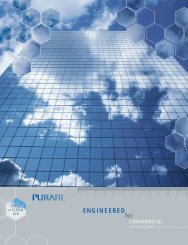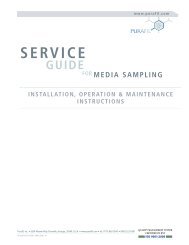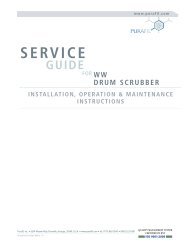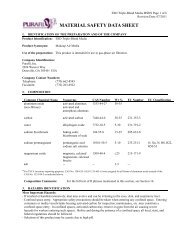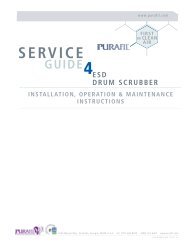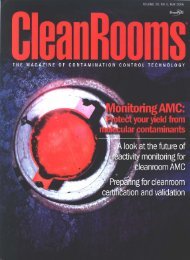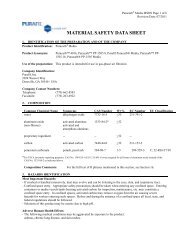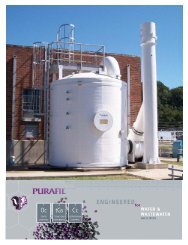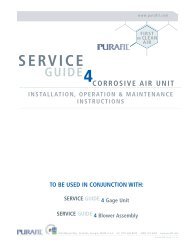How the Changing Regulatory Landscape is Affecting ... - Purafil
How the Changing Regulatory Landscape is Affecting ... - Purafil
How the Changing Regulatory Landscape is Affecting ... - Purafil
Create successful ePaper yourself
Turn your PDF publications into a flip-book with our unique Google optimized e-Paper software.
<strong>How</strong> <strong>the</strong> <strong>Changing</strong> <strong>Regulatory</strong> <strong>Landscape</strong> <strong>is</strong> <strong>Affecting</strong> Equipment Reliability<br />
Grant Crosley<br />
V<strong>is</strong>y Pulp and Paper, Campbellfield VIC Australia<br />
Chr<strong>is</strong> Muller<br />
<strong>Purafil</strong>, Inc., Doraville, Georgia, USA<br />
ABSTRACT<br />
The European Union directive 2002/95/EC “on <strong>the</strong> Restriction of <strong>the</strong> use of certain Hazardous Substances in<br />
electrical and electronic equipment” (RoHS) was implemented in July 2006. Th<strong>is</strong> was <strong>the</strong> first of many regulations<br />
with <strong>the</strong> shared aim of <strong>the</strong> elimination of lead in electronic products. <strong>How</strong>ever, ongoing research has shown that<br />
printed circuit boards made using lead-free materials can be more susceptible to corrosion and that lead-free<br />
products with immersion silver (ImmAg) surface fin<strong>is</strong>h are particularly susceptible to corrosion in high sulfur<br />
environments – <strong>the</strong> same environments found in pulp and paper manufacturing.<br />
Th<strong>is</strong> paper will d<strong>is</strong>cuss RoHS compliance <strong>is</strong>sues and <strong>the</strong> resulting potential for corrosion-related problems. Data will<br />
be presented that illustrates corrosive environments ex<strong>is</strong>t in locations that would o<strong>the</strong>rw<strong>is</strong>e be considered benign if<br />
not for <strong>the</strong> changes in electronic equipment mandated by RoHS leg<strong>is</strong>lation. <strong>How</strong>ever, <strong>the</strong>se problems can be<br />
addressed by continuous monitoring of <strong>the</strong> environment and <strong>the</strong> control of corrosive contaminants where indicated.<br />
Ultimately, <strong>the</strong> successful implementation of an electronic equipment reliability program requires; (1) knowledge<br />
and understanding that corrosion of electronic equipment <strong>is</strong> a serious problem, (2) commitment to a monitoring<br />
program to describe <strong>the</strong> potential for electronic equipment failure, (3) commitment to an integrated contamination<br />
control system, and (4)commitment to take corrective action whenever necessary.<br />
INTRODUCTION<br />
In 1998, <strong>the</strong> European Union (EU) d<strong>is</strong>covered that alarmingly large amounts of hazardous waste were being dumped<br />
into landfill sites. Trends also indicated that <strong>the</strong> volumes were likely to grow 3-5 times faster than average municipal<br />
waste. Th<strong>is</strong> highlighted a massive, and growing, source of environmental contamination.<br />
In order to address <strong>the</strong>se <strong>is</strong>sues, <strong>the</strong> member states of <strong>the</strong> EU decided to create <strong>the</strong> Waste Electrical and Electronics<br />
Equipment (WEEE, 2002/96/EC) directive, whose purpose was to:<br />
1. Improve manufacturers’ designs to reduce <strong>the</strong> creation of waste,<br />
2. Make manufacturers responsible for certain phases of waste management,<br />
3. Separate collections of electronic waste (from o<strong>the</strong>r types of waste), and<br />
4. Create systems to improve treatment, refuse, and recycling of WEEE.<br />
The WEEE directive laid <strong>the</strong> groundwork for additional leg<strong>is</strong>lation and a proposal called EEE (Environment of<br />
Electrical & Electronics Equipment) was also introduced along <strong>the</strong> same lines. <strong>How</strong>ever, now th<strong>is</strong> policy <strong>is</strong><br />
generally referred to as <strong>the</strong> RoHS Directive and <strong>is</strong> often referred to as “Lead-Free” leg<strong>is</strong>lation. Th<strong>is</strong> <strong>is</strong> not a very<br />
accurate nickname, because it extends to o<strong>the</strong>r pollutants as well.<br />
The European Union (EU) directive 2002/95/EC “on <strong>the</strong> Restriction of <strong>the</strong> use of certain Hazardous Substances in<br />
electrical and electronic equipment” or RoHS was implemented in July 2006. Th<strong>is</strong> directive applies to electrical and<br />
electronic equipment designed for use with a voltage rating not exceeding 1,000 volts for alternating current and<br />
1,500 volts for direct current. The requirements of th<strong>is</strong> directive are applicable to <strong>the</strong> member states of <strong>the</strong> European<br />
Union.<br />
The purpose of <strong>the</strong> directive <strong>is</strong> to restrict <strong>the</strong> use of hazardous substances in electrical and electronic equipment and<br />
to contribute to <strong>the</strong> protection of human health and <strong>the</strong> environmentally sound recovery and d<strong>is</strong>posal of waste<br />
electrical and electronic equipment. The EU's RoHS Directive restricts <strong>the</strong> use of six substances in electrical and<br />
electronic equipment: mercury (Hg), lead (Pb), hexavalent chromium (Cr(VI)), cadmium (Cd), polybrominated<br />
biphenyls (PBB) and polybrominated diphenyl e<strong>the</strong>rs (PBDE).<br />
Proceedings of 2009 TAPPI Engineering, Pulping, Environmental Conference: Innovations in Energy, Fiber and Compliance<br />
October 11-14, 2009 – Memph<strong>is</strong>, Tennessee (USA)
In order to comply with <strong>the</strong> EU ROHS leg<strong>is</strong>lation, all of <strong>the</strong>se substances must ei<strong>the</strong>r be removed, or must be<br />
reduced to within maximum permitted concentrations, in any products containing electrical or electronic<br />
components that will be sold within <strong>the</strong> European Union. Manufacturers have made significant investments in new<br />
processes that will eliminate <strong>the</strong>se substances – especially lead.<br />
All applicable products in <strong>the</strong> EU market must now pass RoHS compliance. In short, RoHS impacts <strong>the</strong> entire<br />
electronics industry and compliance violations are costly – product quarantine, transport, rework, scrap, lost sales<br />
and man-hours, legal action, etc. Non-compliance also reflects poorly on brand and image and undercuts ongoing<br />
environmental and “due diligence” activities.<br />
RoHS – THE EU AND BEYOND<br />
Companies selling a broad range of electrical goods in <strong>the</strong> EU must now conform to WEEE and those same<br />
companies must also conform to RoHS. WEEE and RoHS rules, while laid down at <strong>the</strong> European level, are put into<br />
law at <strong>the</strong> national level. When exporting to Europe, it <strong>is</strong> essential to comply with national law in each relevant<br />
country. The EU law simply serves as a template for national laws, which may differ considerably. European<br />
countries currently requiring conformance with <strong>the</strong> EU RoHS Directive include: Austria, Belgium, Bulgaria, Croatia,<br />
Cyprus, Czech Republic, Denmark, Estonia, Finland, France, Germany, Greece, Hungary, Ireland, Italy, Latvia,<br />
Lithuania, Luxembourg, Malta, Ne<strong>the</strong>rlands, Norway, Poland, Portugal, Romania, Slovak Republic, Slovenia, Spain,<br />
Sweden, Switzerland, Turkey, and <strong>the</strong> United Kingdom. *<br />
China RoHS regulations have also been put into effect and many consider <strong>the</strong>m to be considerably more restrictive<br />
than those passed in <strong>the</strong> EU. As described by a potentially-impacted customer: “Without exemptions, it <strong>is</strong><br />
impossible to build a compliant board” [1]. Although, <strong>the</strong> regulations are different and are based on different<br />
processes, <strong>the</strong> aims are similar. Convergence of <strong>the</strong> regulations <strong>is</strong> not foreseen at present, as it would require highlevel<br />
negotiations between <strong>the</strong> EU and China and changes of approach [2].<br />
RoHS regulations are also ei<strong>the</strong>r in effect or pending in many countries – including <strong>the</strong> United States. Additional<br />
RoHS (-like) regulations include:<br />
- Argentina has both a WEEE and RoHS bill.<br />
- Australia <strong>is</strong> conducting a survey.<br />
- Brazil senate bill PL 173/2009 proposes RoHS for all computer and IT equipment sold in Brazil.<br />
- Japan Green Procurement Survey Standardization Initiative (JGPSSI) adopted “RoHS” labeling requirements for<br />
certain products.<br />
- Korea <strong>is</strong> considering RoHS leg<strong>is</strong>lation.<br />
- Taiwan has a voluntary RoHS program.<br />
U.S. State bills:<br />
- California SB20/SB50 – “Covered Electronic Waste Payment System” has <strong>the</strong> same requirements as EU RoHS<br />
except that its scope includes only products with d<strong>is</strong>plays larger than 4”.<br />
- California AB2202 – includes all EU RoHS products.<br />
- Maine – Title 38, Chapter 16, § 1610 “Electronic waste”<br />
- Minnesota – patterned after EU RoHS, however only for consumer products.<br />
- Several o<strong>the</strong>r states are looking at RoHS leg<strong>is</strong>lation (see Figure 1).<br />
UNINTENDED CONSEQUENCES<br />
An aim shared by almost all RoHS leg<strong>is</strong>lation <strong>is</strong> <strong>the</strong> elimination of lead in electronic products. Thus <strong>the</strong> main <strong>is</strong>sue<br />
for <strong>the</strong> electronics industry became <strong>the</strong> use of lead in <strong>the</strong> manufacture of components and circuit board assemblies.<br />
* Note that Croatia, Norway, and Switzerland are not part of <strong>the</strong> EU. They may never<strong>the</strong>less have leg<strong>is</strong>lation implementing EU WEEE and RoHS<br />
rules, or similar leg<strong>is</strong>lation.<br />
Proceedings of 2009 TAPPI Engineering, Pulping, Environmental Conference: Innovations in Energy, Fiber and Compliance<br />
October 11-14, 2009 – Memph<strong>is</strong>, Tennessee (USA)
A printed circuit board, or PCB, <strong>is</strong> used<br />
to mechanically support and<br />
electrically connect electronic<br />
components using conductive<br />
pathways, or traces, laminated onto a<br />
non-conductive substrate. Alternative<br />
names are printed wiring board (PWB),<br />
and etched wiring board. A PCB<br />
populated with electronic components<br />
<strong>is</strong> a printed circuit assembly (PCA),<br />
also known as a printed circuit board<br />
assembly (PCBA).<br />
All PCBs have conducting layers on<br />
<strong>the</strong>ir surface typically made of thin<br />
copper foil. If <strong>the</strong> copper <strong>is</strong> left<br />
unprotected, it will oxidize and<br />
deteriorate. Traditionally, any exposed<br />
copper was plated with lead (-based)<br />
solder by <strong>the</strong> hot air solder leveling<br />
(HASL) process.<br />
Figure 1. Colored areas denote active or pending RoHS leg<strong>is</strong>lation<br />
HASL has been working well for many years, <strong>is</strong> <strong>the</strong> predominant surface fin<strong>is</strong>h used in <strong>the</strong> industry, and <strong>is</strong> also <strong>the</strong><br />
cheapest PCB available. Now RoHS essentially makes PCBs using <strong>the</strong> HASL process obsolete. Failure modes on<br />
o<strong>the</strong>r common lead-free PCB fin<strong>is</strong>hes such as Organic Solder Preservative (OSP) and electroless-nickel immersion<br />
gold (ENIG) make <strong>the</strong>se technologies undesirable. As a result, alternatives such as immersion silver (ImmAg) and<br />
organically coated copper (OCC) are currently used as board fin<strong>is</strong>hes. Due to inherent processing difficulties with<br />
OCC boards, ImmAg boards are becoming <strong>the</strong> standard PCB fin<strong>is</strong>h in <strong>the</strong> electronics industry [3].<br />
Immersion silver would seem to have a bright future under RoHS [4]. It <strong>is</strong> easy to apply to <strong>the</strong> boards, relatively<br />
inexpensive, and usually performs well. While ENIG presently has a larger market share, over <strong>the</strong> past 12 months<br />
more immersion silver process lines have been installed in PCB facilities than any o<strong>the</strong>r fin<strong>is</strong>h. <strong>How</strong>ever, some<br />
manufacturers have complained about <strong>is</strong>sues with corrosion. If severe enough, th<strong>is</strong> could lead to shorts and ultimate<br />
failure of <strong>the</strong> board.<br />
The Instrument Society of America (ISA) Standard 71.04 [5] classifies several levels of environmental severity for<br />
electrical and electronic systems: G1, G2, G3 and GX, providing a measure of <strong>the</strong> corrosion potential of an<br />
environment (Table I). G1 <strong>is</strong> benign and GX <strong>is</strong> open-ended and <strong>the</strong> most severe.<br />
Table I. Classification of Reactive Environments<br />
Class<br />
Severity<br />
Level<br />
Copper<br />
Reactivity †<br />
G1 Mild
In a study performed by Rockwell Automation [6] looking at lead-free fin<strong>is</strong>hes, four alternate PCB fin<strong>is</strong>hes were<br />
subjected to an accelerated mixed flowing gas corrosion test. Important findings can be summarized as follows:<br />
1) The immersion gold (ENIG) and immersion silver (ImmAg) surface fin<strong>is</strong>hes failed early in <strong>the</strong> testing. These<br />
coatings are <strong>the</strong> most susceptible to corrosion failures and are expected to be much more susceptible than<br />
traditional HASL coatings. The use of <strong>the</strong>se two coatings may make <strong>the</strong> PCB <strong>the</strong> weak link with regard to <strong>the</strong><br />
sensitivities of <strong>the</strong> electronic devices to corrosion.<br />
2) None of <strong>the</strong> coatings can be considered immune from failure in an ISA Class G3 environment.<br />
3) The gold and silver coatings could not be expected to survive a mid to high Class G2 environment based on<br />
<strong>the</strong>se test results.<br />
A leading world authority on RoHS, ERA Technology, has also reported that, “Recent research has shown that<br />
printed circuit boards made using lead-free materials can be more susceptible to corrosion than <strong>the</strong>ir tin/lead<br />
counterparts.” Industry <strong>is</strong> working diligently to address <strong>the</strong>se concerns but <strong>the</strong>y cannot be addressed overnight.<br />
The Reliability and Failure Analys<strong>is</strong> group at ERA Technology has diagnosed failures in electronic devices due to<br />
interaction with low levels of gaseous sulfides – failures that caused both a financial impact to <strong>the</strong> manufacturers<br />
and safety <strong>is</strong>sues with <strong>the</strong>ir customers. Recent work showed that corrosion could occur even with measured<br />
hydrogen sulfide levels as low as 0.2µg/m 3 (0.14 ppb). Ano<strong>the</strong>r reference describes <strong>the</strong> formation of a 200 angstrom<br />
(20 nanometers) thick layer of silver sulfide in 100 hours at a concentration of just 100µg/m 3 (72 ppb) [7]. Th<strong>is</strong> <strong>is</strong><br />
<strong>the</strong> equivalent of an ISA Class G3 severity level.<br />
THE REALITY OF RoHS<br />
Corrosion-induced failures have been and continue to be frequent in electronics products used in industrial<br />
environments. A typical failure mechan<strong>is</strong>m of electronic systems in <strong>the</strong>se environments <strong>is</strong> <strong>the</strong> reaction of<br />
atmospheric sulfur with exposed metals – particularly copper and silver. These metals are found in PCB traces,<br />
integrated circuit (IC) leads and device terminations. Copper sulfide (Cu 2 S) or silver corrosion products can grow<br />
and creep across surfaces such as IC packages and PCB substrates.<br />
H<strong>is</strong>torically, <strong>the</strong> use of silver in<br />
electronic assemblies has been a<br />
reliability r<strong>is</strong>k unless <strong>the</strong> silver <strong>is</strong><br />
protected from <strong>the</strong> environment. Silver<br />
creep corrosion (electromigration) can<br />
occur quite readily in humid<br />
environments especially in <strong>the</strong> presence<br />
of small amounts of atmospheric sulfur<br />
and chlorides which are common in<br />
many paper mill environments. More<br />
than twenty years ago manufacturers of<br />
d<strong>is</strong>tributed control systems (DCS) such<br />
as Digital Equipment Corporation<br />
(DEC), ABB, and Honeywell described<br />
<strong>the</strong>ir concerns regarding equipment<br />
corrosion in research documents,<br />
technical papers, and site planning<br />
guides. These companies also provided<br />
guidance in terms of environmental<br />
conditions necessary to protect <strong>the</strong>ir<br />
computer equipment (Figure 2).<br />
Manufacturers of industrial computer<br />
equipment still specify <strong>the</strong> control of<br />
corrosive gases in <strong>the</strong>ir site planning<br />
guides and/or <strong>the</strong> terms and conditions<br />
Figure 2. Copper corrosion rate d<strong>is</strong>tribution guidelines [8].<br />
Proceedings of 2009 TAPPI Engineering, Pulping, Environmental Conference: Innovations in Energy, Fiber and Compliance<br />
October 11-14, 2009 – Memph<strong>is</strong>, Tennessee (USA)
necessary to maintain warranties and service contracts. Even in environments previously considered benign with<br />
regards to electronics corrosion serious problems as a direct result of RoHS compliance are being reported.<br />
One failure mechan<strong>is</strong>m caused by <strong>the</strong> lead-free transition was not foreseen by <strong>the</strong> industry. It was soon d<strong>is</strong>covered<br />
that lead-free products with an immersion silver (ImmAg) surface fin<strong>is</strong>h will creep corrode in what some electronic<br />
equipment manufacturers consider to be high sulfur environments (ISA Class G2 or higher). The majority of creep<br />
corrosion failures occurred on hard d<strong>is</strong>k drives (HDD), graphic cards, and mo<strong>the</strong>rboards in desktop or workstation<br />
systems (only those with ImmAg PCB fin<strong>is</strong>h were affected).<br />
Echoing <strong>the</strong> study by Rockwell, Hewlett Packard documented several case studies where creep corrosion of ImmAg<br />
fin<strong>is</strong>h caused failures of computer systems in high sulfur environments (Mazurkiewicz 2006). It was stated that<br />
sulfur-based corrosion failures increased dramatically upon introduction of ImmAg surface fin<strong>is</strong>h on computer<br />
products (due to ROHS requirements). Alcatel-Lucent also has experience with th<strong>is</strong> <strong>is</strong>sue in a paper detailing <strong>the</strong>ir<br />
work with mixed flowing gas testing of various lead-free surface fin<strong>is</strong>hes and <strong>the</strong>ir res<strong>is</strong>tance to creep corrosion [9].<br />
Analys<strong>is</strong> revealed <strong>the</strong> corrosion products to be copper sulfide (Cu 2 S) and silver sulfide (Ag 2 S). High amounts of<br />
Cu 2 S typically indicate <strong>the</strong> presence of active sulfur compounds such as elemental sulfur (S), hydrogen sulfide (H 2 S),<br />
or organic sulfur compounds such as mercaptans. Ag 2 S can also be formed by <strong>the</strong>se contaminants but can also be<br />
formed by exposure to sulfur oxide (SOx) contamination.<br />
The most common failures are with <strong>the</strong> most common components, with <strong>the</strong> highest incidence of failures being<br />
found in capacitors, plastic encapsulated microcircuits (PEMs) and printed circuit boards (PCBs). A University of<br />
Maryland study of field failures from 70 companies revealed 30% of ALL failures were capacitors – mainly MLCCs<br />
(multilayer chip capacitors) [10].<br />
Corrosion-induced failures are frequent in electronic products used in <strong>the</strong>se environments with a typical failure<br />
mechan<strong>is</strong>m being <strong>the</strong> reaction of atmospheric sulfur with exposed metals – particularly copper and silver. Corrosion<br />
can occur quite rapidly in humid environments especially in <strong>the</strong> presence of small amounts of atmospheric sulfur<br />
and chlorides resulting in (among o<strong>the</strong>r things) intermittent equipment malfunctions, unplanned shutdowns, or<br />
failure of critical systems.<br />
Recognizing <strong>the</strong> severity of <strong>the</strong> problem, most of <strong>the</strong> world's leading manufacturers of process measurement and<br />
control systems require that customers use <strong>the</strong> International Society for Automation (ISA) Standard ISA-71.04-1985<br />
or o<strong>the</strong>r similar standards to determine levels of airborne contaminants to maintain warranties and service contracts.<br />
These standards provide achievable and effective guidelines to protect electronics and electrical equipment from <strong>the</strong><br />
damaging effects of corrosive gases. They classify environmental severity levels for electrical and electronic<br />
systems and provide a measure of <strong>the</strong> corrosion potential of an environment typically defined in terms of <strong>the</strong> rate at<br />
which <strong>the</strong>y react with copper. <strong>How</strong>ever, with <strong>the</strong> passage of RoHS leg<strong>is</strong>lation, and <strong>the</strong> switch to lead-free fin<strong>is</strong>hes<br />
such as ImmAg, many control systems manufacturers and end-users are now questioning whe<strong>the</strong>r th<strong>is</strong> copper-only<br />
environmental monitoring <strong>is</strong> adequate or <strong>is</strong> even still relevant.<br />
Although silver <strong>is</strong> not an equipment reliability determinant in <strong>the</strong> ISA standard, it has been long been included as<br />
part of environmental monitoring programs. Reactivity (corrosion) monitoring using both copper and silver<br />
corrosion data provide a more complete environmental assessment than <strong>the</strong> copper-only monitoring described in<br />
Standard 71.04. Th<strong>is</strong> standard <strong>is</strong> currently undergoing a long past-due update to incorporate <strong>the</strong> use of silver<br />
corrosion data into quantifiable severity levels that directly relate to equipment reliability.<br />
For instance, some environments that are non-corrosive to copper, and thus considered harmless to equipment (by<br />
<strong>the</strong> ISA standard), are extremely corrosive to silver. While th<strong>is</strong> alone does not necessarily indicate an environment<br />
requiring direct control of contaminants, it does point out <strong>the</strong> potential for corrosion-related problems. Much of <strong>the</strong><br />
new equipment purchased and installed over <strong>the</strong> last couples of years contains silver due to RoHS compliances and<br />
failure rates for some components are now being measured in weeks instead of years.<br />
Corrosive gases have been and continue to be a problem in <strong>the</strong> paper industry. The use of recycled fiber <strong>is</strong> increasing<br />
at <strong>the</strong> same time that electrical and electronic equipment <strong>is</strong> becoming more soph<strong>is</strong>ticated and complex. Significant<br />
quantities of corrosive gases are being generated from <strong>the</strong> paper making process and <strong>the</strong> equipment required to<br />
Proceedings of 2009 TAPPI Engineering, Pulping, Environmental Conference: Innovations in Energy, Fiber and Compliance<br />
October 11-14, 2009 – Memph<strong>is</strong>, Tennessee (USA)
maximize process efficiency <strong>is</strong> being adversely affected. Direct and indirect costs of failures due to corrosion run<br />
into many hundreds of thousands of dollars a year at individual mills. Corrosion <strong>is</strong> also an increasing safety concern,<br />
particularly on higher voltage systems.<br />
There <strong>is</strong> a growing concern in pulp and paper and o<strong>the</strong>r process industries that using copper-only reactivity<br />
monitoring results can seriously understate <strong>the</strong> potential for equipment failure in <strong>the</strong>se environments. And now due<br />
to RoHS compliance, many environments previously considered benign with regards to electronics corrosion are<br />
experiencing serious problems. Electronic equipment manufacturers have to comply with RoHS and many have<br />
taken <strong>the</strong> ImmAg route as <strong>the</strong>ir path to compliance. Th<strong>is</strong> has taken care of one <strong>is</strong>sue – <strong>the</strong> elimination of lead – but<br />
has presented new challenges with regards to equipment reliability.<br />
RoHS AND RELIABILITY<br />
The requirement for corrosion control in industrial environments remains constant. <strong>How</strong>ever, more companies are<br />
now taking a much closer look at developing or updating specifications due to <strong>the</strong> changes made by controls<br />
manufacturers to comply with <strong>the</strong> RoHS restrictions on <strong>the</strong> use of lead. Th<strong>is</strong> includes specifying an ISA Class G1<br />
environment for control rooms, etc., where in <strong>the</strong> past a Class G2 environment was considered acceptable.<br />
Specifications are also now showing up requiring <strong>the</strong> measurement and quantification of silver corrosion rates and<br />
<strong>the</strong> related corrosion products.<br />
With many control systems manufacturers opting to use <strong>the</strong> ImmAg process for <strong>the</strong>ir PCBs and o<strong>the</strong>r electrical<br />
components, and <strong>the</strong> fact that silver <strong>is</strong> much more sensitive to lower levels of corrosive gases, we have already seen<br />
increased concerns over equipment reliability. As <strong>the</strong> National Reliability Manager for one pulp and paper<br />
manufacturer described it, “The ISA Standard <strong>is</strong> becoming irrelevant because it does not take into account silver<br />
corrosion. All of <strong>the</strong> new equipment purchased over <strong>the</strong> last year contains silver and <strong>the</strong> failure rate for some<br />
components <strong>is</strong> now being measured in months instead of years.”<br />
Problems with RoHS-Compliant Equipment<br />
A recycled paper mill began a project in 2006 to replace obsolete equipment that could no longer be supported (no<br />
manufacturer technical support, lack of spares, etc.) with new DCS and programmable logic controls (PLCs). The<br />
original hardware had been installed for 15 years and had proven to be reliable and robust. One contributing factor<br />
to th<strong>is</strong> was <strong>the</strong> fact that many of <strong>the</strong> locations where th<strong>is</strong> equipment had been installed were classified as ISA Class<br />
G1 for copper. <strong>How</strong>ever, <strong>the</strong> corresponding silver corrosion rates were up to 20x higher and essentially all of <strong>the</strong><br />
silver corrosion reported from <strong>the</strong> analys<strong>is</strong> of corrosion classification coupon (CCCs) collected over several years<br />
was due to sulfur corrosion. Th<strong>is</strong> presented some concern based on changes to <strong>the</strong> equipment due to RoHS<br />
compliance.<br />
Before starting <strong>the</strong> replacement program, mill staff was very aware of copper corrosion and <strong>the</strong> reliability r<strong>is</strong>ks<br />
associated with exceeding <strong>the</strong> ISA severity levels specified by <strong>the</strong> equipment manufacturers. Routine CCC<br />
monitoring results showed that copper corrosion was significant but not extreme in many locations; however, <strong>the</strong><br />
corresponding silver corrosion rates were routinely much higher. On average <strong>the</strong> silver corrosion rate was 10x that<br />
for <strong>the</strong> corresponding G1 copper rate (Table II).<br />
Within three months of replacing <strong>the</strong> old systems, <strong>the</strong> mill began experiencing frequent failures of <strong>the</strong> input/output<br />
(I/O) stations installed on <strong>the</strong> process fieldbus (PROFIBUS). ‡ A lot of work was put into making <strong>the</strong> PROFIBUS<br />
installations error-free, and <strong>the</strong> architectures were reengineered to follow <strong>the</strong> core rules prec<strong>is</strong>ely (i.e., <strong>the</strong> systems<br />
were pulled back to very simple, straight-line installations).<br />
These I/O stations or nodes have a number of I/O modules attached to <strong>the</strong>m and communicate <strong>the</strong> inputs and outputs<br />
over <strong>the</strong> PROFIBUS with <strong>the</strong> DCS. Since <strong>the</strong> problems were intermittent and symptoms appeared related to<br />
PROFIBUS communication or installation, a full diagnostic process was implemented to capture any and all<br />
information about each failure. Th<strong>is</strong> included examination of <strong>the</strong> hardware, <strong>the</strong> hardware location, its position on <strong>the</strong><br />
‡ PROFIBUS <strong>is</strong> <strong>the</strong> dominant fieldbus, with more than 4.8 million of <strong>the</strong>se installed in <strong>the</strong> process industries by <strong>the</strong> end of 2008. Utilizing a<br />
single-cable “bus” structure, fieldbus eliminates hardwiring in <strong>the</strong> automation of production lines (http://www.profibus.com/).<br />
Proceedings of 2009 TAPPI Engineering, Pulping, Environmental Conference: Innovations in Energy, Fiber and Compliance<br />
October 11-14, 2009 – Memph<strong>is</strong>, Tennessee (USA)
us, architectures, and software settings. Through systematic investigation and analys<strong>is</strong>, several potential causes<br />
were eliminated and root cause analys<strong>is</strong> for <strong>the</strong> remaining <strong>is</strong>sues was performed.<br />
Table II. Paper Mill CCC Analys<strong>is</strong> Results §<br />
Location Cu 2 S Cu 2 O CuUnk Copper Total ISA Class AgCl Ag 2 S AgUnk Silver Total<br />
DC Drive Room 0 142 0 142 G1 0 2455 0 2455<br />
DC Drive Room 961 201 0 1162 G3 0 4909 0 4909<br />
DC Drive Room 2303 975 0 3278 GX 0 3704 0 3704<br />
DCS Room 0 118 0 118 G1 0 1590 0 1590<br />
Electrical Room 0 81 0 81 G1 0 1636 0 1636<br />
Motor Control Center D 275 95 0 370 G2 0 1964 0 1964<br />
Motor Control Center H (1) 533 131 0 664 G2 0 1289 0 1289<br />
Motor Control Center H (2) 518 144 0 662 G2 0 1269 0 1269<br />
Motor Control Center H (3) 396 85 0 481 G2 0 438 139 577<br />
Motor Control Center H (4) 212 45 0 257 G1 0 1460 0 1460<br />
Paper Machine MCC 152 65 0 217 G1 0 1590 0 1590<br />
Paper Machine Rack Room 509 142 0 651 G2 0 1932 0 1932<br />
PLC Room 1263 159 0 1422 G3 0 4009 0 4009<br />
Server Room 0 106 0 106 G1 0 1870 0 1870<br />
Winder Motor Control Center 160 55 0 215 G1 0 1621 0 1621<br />
Mill staff recognized that <strong>the</strong> res<strong>is</strong>tance of a choke installed on <strong>the</strong> base unit of <strong>the</strong> I/O station to eliminate signal<br />
no<strong>is</strong>e was increasing and on failed units was a high or open circuit. Ironically enough th<strong>is</strong> choke was only installed<br />
to meet o<strong>the</strong>r European leg<strong>is</strong>lation pertaining to radio frequency interference (RFI) em<strong>is</strong>sions. The critical <strong>is</strong>sue<br />
identified pertaining to th<strong>is</strong> choke was that it <strong>is</strong> an electronic chip design with a very thin layer of silver on <strong>the</strong> IC<br />
legs in compliance with <strong>the</strong> lead-free regulations of RoHS. Corrosion of th<strong>is</strong> silver layer destroyed <strong>the</strong> choke’s<br />
connection to <strong>the</strong> printed circuit and hence <strong>the</strong> high res<strong>is</strong>tance. Consultation with <strong>the</strong> manufacturer confirmed <strong>the</strong><br />
presence of silver on <strong>the</strong> chokes.<br />
The mill was already in <strong>the</strong> process of installing air cleaning equipment to remove corrosive gases from <strong>the</strong> air and<br />
reduce <strong>the</strong> rates of copper corrosion, however, <strong>the</strong> extremely short time to failure for <strong>the</strong>se silver-containing<br />
components accelerated th<strong>is</strong> effort in order to prevent additional failures. Staff <strong>is</strong> confident that <strong>the</strong>se failures were<br />
purely <strong>the</strong> results of RoHS compliance and <strong>the</strong> use of silver. The lack of information and warnings by <strong>the</strong> supplier<br />
regarding potential <strong>is</strong>sues related to <strong>the</strong>ir RoHS compliance programs <strong>is</strong> troubling considering that even when<br />
presented with th<strong>is</strong> evidence, <strong>the</strong>y still concluded <strong>the</strong>se failures were due to “installation errors.”<br />
Potential Problems Ex<strong>is</strong>t at all Mills<br />
CCC data from several additional mills (Table III) show that many locations exhibiting an ISA Class G1<br />
environment for copper have silver corrosion rates that would indicate serious cause for concern for any electronic<br />
equipment using an ImmAg surface fin<strong>is</strong>h specifically or any silver or silver-plated components in general.<br />
Ano<strong>the</strong>r contributing factor to concerns over <strong>the</strong> increased use of silver in industrial applications <strong>is</strong> that even with<br />
tightened control requirements for o<strong>the</strong>r environmental parameters (e.g., temperature and humidity) and <strong>the</strong> positive<br />
effect th<strong>is</strong> has on <strong>the</strong> rate of copper corrosion, silver can still exhibit high rates of corrosion even in well-controlled<br />
environments. Closer examination of th<strong>is</strong> CCC database shows that in locations reported as ISA Class G1 for copper<br />
corrosion, <strong>the</strong> corresponding silver corrosion rate can be up to 10x higher. Fur<strong>the</strong>rmore, every CCC analyzed shows<br />
evidence of sulfur contamination (as Ag 2 S). On average, <strong>the</strong> amount of silver corrosion measured <strong>is</strong> double that of<br />
<strong>the</strong> copper corrosion reported [11].<br />
§ The total corrosion measured <strong>is</strong> actually <strong>the</strong> sum of individual corrosion films: Cu 2 S = copper sulfide, Cu 2 O = copper oxide, CuUnk = copper<br />
unknowns, AgCl = silver chloride, Ag 2 S = silver sulfide, AgUnk = silver unknowns. All data <strong>is</strong> normalized to a 30-day exposure.<br />
Proceedings of 2009 TAPPI Engineering, Pulping, Environmental Conference: Innovations in Energy, Fiber and Compliance<br />
October 11-14, 2009 – Memph<strong>is</strong>, Tennessee (USA)
Table III. Pulp and Paper Mill CCC Data [11]<br />
Location Area/Room Cu 2 S Cu 2 O CuUnk Copper Total ISA Class AgCl Ag 2 S AgUnk Silver Total<br />
AHU Room 0 180 0 180 G1 0 3142 0 3142<br />
Austria DCS Room 182 78 0 260 G1 0 3491 0 3491<br />
Electrical Room 115 46 0 161 G1 0 1582 0 1582<br />
Control Room 192 101 0 293 G1 0 1042 0 1042<br />
Brazil Operations Room 205 88 0 293 G1 0 1234 0 1234<br />
MCC 0 125 0 125 G1 0 948 0 948<br />
DCS Room 182 104 0 286 G1 0 1022 0 1022<br />
China Wet End Control 182 78 0 260 G1 0 1118 0 1118<br />
Computer Room 124 44 0 168 G1 0 5467 0 5467<br />
DCS Cabinet 0 118 0 118 G1 0 1636 0 1636<br />
Finland MCC 0 106 0 106 G1 0 2634 0 2634<br />
Control Room 0 150 0 150 G1 0 2796 0 2796<br />
Mechanical Room 0 68 0 68 G1 0 2182 0 2182<br />
Holland Server Room 0 78 0 78 G1 0 1964 0 1964<br />
Splicer Room 0 105 0 105 G1 0 1145 0 1145<br />
Control Room 0 173 0 173 G1 0 1497 0 1497<br />
Japan IPC Room 0 231 0 231 G1 0 2145 0 2145<br />
DCS Room 215 62 0 277 G1 0 1038 0 1038<br />
DCS Panel 187 61 0 248 G1 0 1848 0 1848<br />
Korea MCC Room 204 56 0 260 G1 0 1810 0 1810<br />
PLC Panel 102 50 0 160 G1 0 1155 0 1155<br />
Electrical Room 172 34 0 206 G1 35 1315 0 1340<br />
USA Wet End Drives 196 81 0 277 G1 0 1565 0 1565<br />
Control Room 175 86 0 261 G1 0 5073 0 5073<br />
Contaminant gases containing sulfur, such as SO 2 (sulfur dioxide) and H 2 S, are <strong>the</strong> most common gases in paper<br />
mills, refineries, chemical plants, etc. that cause hardware corrosion and corrosion control in industrial environments<br />
<strong>is</strong> acknowledged as a requirement to assure electrical and electronic equipment reliability. One example of<br />
component failure <strong>is</strong> from sulfur gases entering a component package and attacking <strong>the</strong> silver resulting in <strong>the</strong><br />
formation of Ag 2 S. The mechanical pressure created by <strong>the</strong> Ag 2 S formation inside <strong>the</strong> package damaged its<br />
mechanical integrity and caused <strong>the</strong> device to fail [12]. Th<strong>is</strong> and o<strong>the</strong>r failure mechan<strong>is</strong>ms are becoming common<br />
occurrences when using RoHS-compliant electronic equipment and components produced using <strong>the</strong> ImmAg process,<br />
and to a lesser degree, <strong>the</strong> ENIG process.<br />
To maintain a high level of equipment dependability and availability, it should be understood that a control room <strong>is</strong><br />
a dynamic environment where many maintenance operations, infrastructure upgrades, and equipment change<br />
activities occur on a regular bas<strong>is</strong>. Airborne contaminants harmful to sensitive electronic devices can be introduced<br />
into <strong>the</strong> operating environment in many ways in addition to <strong>the</strong> ventilation system. For instance, chlorine can be<br />
emitted from PVC insulation use on wires and cables if temperatures inside <strong>the</strong> DCS cabinets get too high. <strong>How</strong>ever,<br />
it <strong>is</strong> still <strong>the</strong> outdoor ambient air used for cooling and pressurization that remains <strong>the</strong> primary source of corrosive<br />
contaminants and it should be cleaned before its introduction into <strong>the</strong> control room environment.<br />
With <strong>the</strong> changes to process control equipment due to <strong>the</strong> RoHS directives, plant managers and operators should<br />
include an environmental contamination monitoring and control section as part of an overall site planning, r<strong>is</strong>k<br />
management, mitigation, and improvement plan.<br />
Included in th<strong>is</strong> plan should be considerations for <strong>the</strong> assessment of <strong>the</strong> outdoor air and indoor environment with<br />
regards to corrosion potential. ISA Standard 71.04 can be used to provide site-specific data on <strong>the</strong> types and levels<br />
of gaseous contamination and <strong>the</strong> amount of corrosion being formed. CCCs can be used as a survey tool to establ<strong>is</strong>h<br />
baseline data necessary to determine if and what type of environmental controls are needed.<br />
The second part of <strong>the</strong> plan should be <strong>the</strong> development and specification of a specific contamination control<br />
strategy. Corrosion in an indoor environment <strong>is</strong> most often caused by a short l<strong>is</strong>t of chemical contaminants or<br />
Proceedings of 2009 TAPPI Engineering, Pulping, Environmental Conference: Innovations in Energy, Fiber and Compliance<br />
October 11-14, 2009 – Memph<strong>is</strong>, Tennessee (USA)
combinations of contaminants. The contaminants present in a specific room are highly dependant on <strong>the</strong> controls put<br />
in place to mitigate <strong>the</strong>m. Most often th<strong>is</strong> would involve <strong>the</strong> selection and application of <strong>the</strong> appropriate chemical<br />
filtration systems to clean both <strong>the</strong> outdoor ventilation air as well as <strong>the</strong> indoor air.<br />
The final part of <strong>the</strong> plan would be to establ<strong>is</strong>h a real-time environmental monitoring program based on <strong>the</strong> severity<br />
levels establ<strong>is</strong>hed in <strong>the</strong> ISA Standard. Real-time Atmospheric Corrosion Monitors (ACMs) or Continuous<br />
Corrosion Transmitters (CCTs) can provide accurate and timely data on <strong>the</strong> performance of <strong>the</strong> chemical filtration<br />
system as well as <strong>the</strong> room air quality [13].<br />
The absence of gaseous contamination controls can be <strong>the</strong> result of a lack of knowledge and education. Often <strong>the</strong><br />
relationship between corrosion levels and hardware failures in control rooms <strong>is</strong> overlooked or unknown. <strong>How</strong>ever,<br />
due to <strong>the</strong> continuing efforts of companies like ABB, Dell, Honeywell, HP, IBM, Rockwell, Siemens, and o<strong>the</strong>rs,<br />
th<strong>is</strong> knowledge gap <strong>is</strong> shrinking and successful corrosion monitoring and control programs are being developed and<br />
implemented – assuring reliable operation of process measurement and control equipment.<br />
New manufacturing techniques using much thinner conductive components than in previous generations of th<strong>is</strong><br />
equipment, <strong>the</strong> use of silver as a primary surface fin<strong>is</strong>h, and <strong>the</strong> lack of silver standards from ISA are all contributing<br />
factors to an increased r<strong>is</strong>k for electronic process measurement and control equipment used in a paper mill<br />
environment. Fur<strong>the</strong>r, <strong>the</strong> general lack of information from manufacturers regarding <strong>the</strong> changes made for RoHS<br />
compliance and any resulting reliability <strong>is</strong>sues means that environmental monitoring and contamination control will<br />
be mandatory to assure reliable performance and profitable operations.<br />
ONGOING AND FUTURE WORK<br />
The amount of corrosion forming over any given period <strong>is</strong> a primary indicator of how well-controlled an<br />
environment may be. It has been proven that if an environment exhibits a reactivity rate of
Assuring long-term equipment reliability requires working with plant personnel to quantify <strong>the</strong> corrosive potential of<br />
an environment towards <strong>the</strong> various types of electronic equipment in use, providing engineered solutions for gaseous<br />
contaminant control, and ongoing monitoring of <strong>the</strong> controlled environment to assure compliance with standards and<br />
specifications. The successful application of such a corrosion control program in pulp and paper mills, refineries,<br />
chemical plants, and many o<strong>the</strong>r industrial settings will protect critical process measurement and control equipment<br />
and assure profitable manufacturing operations.<br />
REFERENCES<br />
1. Dills, J. (2007) China RoHS Phase 2: Hard Data Reveals a Red Flag,<br />
http://www.emsnow.com/npps/story.cfm?id=24880.<br />
2. Barker, C. and Xing, W. (2007) Comparative Study of European and Chinese Environmental Measures<br />
Restricting Hazardous Substances in Electrical and Electronic Equipment, EU-China Trade Project,<br />
http://www.rohs-international.com/site_files/rohsinternational.com/RoHS_Comparative_Study_Final_Report_EN.pdf.<br />
3. Mazurkiewicz, P. (2006) Accelerated Corrosion of Printed Circuit Boards due to High Levels of Reduced Sulfur<br />
Gasses in Industrial Environments. In: Proceedings of <strong>the</strong> 32nd International Symposium for Testing and Failure<br />
Analys<strong>is</strong>, Austin, Texas, 12-16 November, pp 469-473.<br />
4. UYEMURA International Corporation (2008) Printed Circuit Boards: Final Fin<strong>is</strong>h Options,<br />
http://www.uyemura.com/library-2.htm.<br />
5. ISA (1985) Standard ISA-71.04-1985 – Environmental Conditions for Process Measurement and Control<br />
Systems: Airborne Contaminants, International Society for Automation, Research Triangle Park, North Carolina.<br />
6. Veale, R. (2005) Reliability of PCB Alternate Surface Fin<strong>is</strong>hes in a Harsh Industrial Environment. In:<br />
Proceedings of SMTA International, Rosemont (Chicago), Illino<strong>is</strong>, 25-29 September, pp 494-499.<br />
7. ERA Technology Limited (2007) Guide to <strong>the</strong> Compliance with <strong>the</strong> RoHS Directive,<br />
http://www.era.co.uk/index.asp.<br />
8. Digital Equipment Corporation (1985) Copper Corrosion Rate D<strong>is</strong>tribution Guidelines.<br />
9. Reid, M., Punch, J., Ryan, C. et al. (2007) The Corrosion of Electronic Res<strong>is</strong>tors. IEEE Transactions:<br />
Components and Packaging Technologies, 30(4), 666 – 672.<br />
10. Center for Advanced Life Cycle Engineering (2008) CALCE Long-Term Pb-Free Study,<br />
http://www.calce.umd.edu/lead-free/longterm.htm.<br />
11. <strong>Purafil</strong> (2009) Corrosion Classification Coupon (CCC) Database. Unpubl<strong>is</strong>hed data.<br />
12. Anon (2008) ASHRAE Datacom Series: Particulate and Gaseous Contamination in Datacom Environments.<br />
Unpubl<strong>is</strong>hed.<br />
13. <strong>Purafil</strong> (2009a) Environmental Monitoring & Assessment Tools,<br />
http://www.purafil.com/products/monitoring.aspx.<br />
14. EuroAsia Semiconductor (2006) Substance Regulations, more law!<br />
http://www.euroasiasemiconductor.com/news_full.php?id=7447.<br />
Proceedings of 2009 TAPPI Engineering, Pulping, Environmental Conference: Innovations in Energy, Fiber and Compliance<br />
October 11-14, 2009 – Memph<strong>is</strong>, Tennessee (USA)



